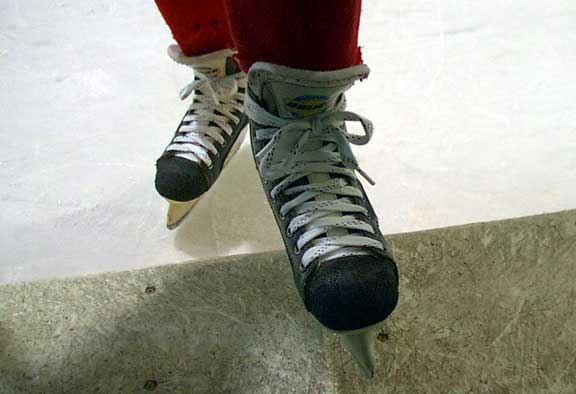|
Cold Feet |
 |
| FTLComm - Tisdale - January 7, 2001 |
| Below is an interesting e-mail message I received yesterday and deals with a common winter problem we need to be able to deal with. |
- |
Brendon every dad has to deal with this one and you are well along the way to solving the problem with good fitting skates. But just in case a parent wants to check the skates to see if they are the right fit here is the first and most important test. Ice skates require that the foot be almost one with the boot to insure complete control over that thin blade of steel running down the middle. To accomplish this, the most important part of the skate boot is the heel. The socket where the individuals heel fits (the counter) must fit the foot, not tightly but be a close fit. When you try on skates the heel is planted firmly into the heel (counter) and the skate is laced to insure that the heel remains in that position. The rest of the skate need only fit snugly and there needs to be about a thumb's width between the end of the toes and the toe cap. With good fitting skates you can have good skating. Lacing them is another issue and dads and moms spend a lot of time working on this, while they get cramps in their fingers and the child gets cold. The laces for the foot from the toes to the last three or four laces holes should be loose. In fact there is no need to strain on these tightening them up that will compact the foot and restrict blood flow guaranteeing cold feet. The last five lace holes need to be tight and tied off, this hockey player has looped the extra lengths around the skate just to keep them out of the way. The initial  tightness
comes with them being tied at the top loop. tightness
comes with them being tied at the top loop.If you look closely at the picture at the top of the page these skates are just right, they fit the boy and the bottom laces are loose enough to slip a finger into, while the tops of the skate are tight holding the heel into the skate's counter. The next issue Brendan is asking about is socks. Thin is the answer. Ordinary light socks. Heavy gym socks that are spongy are a definite problem. They will compress around the foot and you are sure to have a kid with cold feet. A light sock is the answer and the next and absolutely most important issue is "dry". When skates are being put on, make sure that a dry sock is what the child is wearing, wet or damp socks are really a problem. This explains the plastic bag problem. Were you to use a plastic bag the perspiration from the foot would dampen the sock and the result would be rapid cooling, so no plastic bags, not ever. Pro hockey players have their skates custom made and this produces an outstanding fit and as a result few wear socks at all. But all skaters, pro or other wise wear thin socks to keep their feet dry. Now the big secret. For years I was a referee and unlike the players who bust themselves for 90 seconds to two minutes the ref is out their for the whole game. I had to work in country rinks, even outside ones and I learned how to keep warm. During all that time in temperatures often below -30 C, I was on the job with warm feet and warm hands and I did not wear gloves. I avoided gloves because it prevented me from handling the puck well and looking after my whistle, which in very cold conditions will freeze unless held inside a warm hand. The secret is not to worry about the hands and feet. The arms, hands, legs and feet are the first to cool when you get cold and to prevent that from happening keep the body, the torso warm. As a referee I wore a generous layer of fat, then layers of cotton underwear, first, a "t" shirt light sweater and jersey. As long as my body stayed warm my extremities did the same. But again the key is keeping dry. Your clothing must not be allowed to accumulate perspiration or the heat from your body will be wicked away, very rapidly and before you know it your hands and feet will be nearly frozen. (This is true in all low weather conditions, not just skating, if you have cold feet warm up the body, warm boots and socks will do little good if the body itself is cooling.) So when you take your kids skating on an outdoor rink, get them dressed warmly in a manner that the clothes will breath and as they warm up they can take off an outer coat and keep on going. Loose clothes are better than stuffed ones where the outer clothes are compressing the insulation capabilities of the lower layers. For pants, make sure that they are not tight, gym pants over cotton underwear is ideal, blue jeans wear well but lack the ease of movement you want to have as a skater. Remember, to keep those knees bent, lower the centre of gravity and have fun. Don't ignore the head. Most of the heat loss from your body is from your head so wear a hat of some kind, wool is best. As a referee I work my helmet and that did the job for me. |
 |